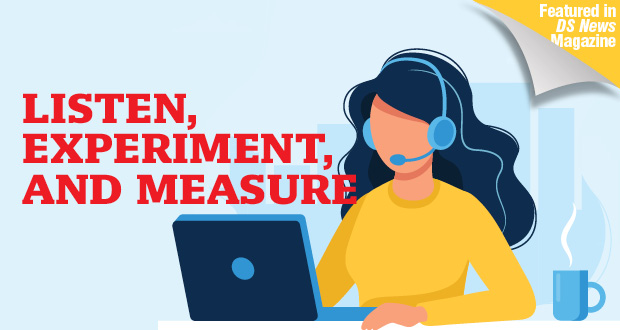
This piece originally appeared in the August edition of DS News, out now.
Customer experience is and always will be at the forefront of an institution’s success. With the pandemic, many people are working from home and the way they interact with businesses and services is changing. Now is the time to ensure your customer experience initiatives are adapting to the new normal and you are doing the right work now to understand any shifts in your customers’ needs and expectations.
To do this, it is vital for customer experience (CX) teams to evaluate how they’re performing in this new normal, get feedback from stakeholders, and test the waters to see if there is something else they can be doing to make sure customer needs are met through more positive experiences.
It’s been pretty crazy lately. When was the last time you checked in with your customers and sales teams to get feedback? Similarly, have you taken a minute to investigate customer data or assess performance of your latest initiatives? If not, now is the time to look at the big picture and test out new methods. For CX teams, here are a few things to keep in mind to make sure that your institution’s customer experience initiatives are optimized:
Listen
While listening is a simple concept, listening well is a core competency for successful CX teams. Constantly pulsing, listening, and developing key actionable insights is beneficial for the company. Foster a curious environment where your team asks questions and pushes on “noble truths” to ensure the customer is getting what they need from your business. You need to know what is working and what is not for both customers and the business itself to build a sustainable customer experience. Similarly, understanding gaps between customer expectations and experience is critical to your institution’s initiatives. Knowing what is top of mind for customers and evolving to accommodate changing expectations will positively impact customer experience. Voice of Customer or VOC programs help institutions accomplish this on whatever scale is necessary.
Customer interviews are always your most direct route to more immediately actionable insights. They allow you to independently collect their candid and honest feedback and maybe even watch them use your product, service, or technology to see how they are using it and if there are any changes that could be made to make key interactions optimized for user-friendliness. Methods like surveys, customer panels, and interviews are always helpful. Additionally, some form of compensation for surveys also goes a long way, if budget allows. Customers are also always receptive to blind
surveys as they feel they can truly answer questions. This provides customer service teams with unbiased opinions. We’ve found a lot of success using third-party customer interviewers who know how to ask the right questions and probe for the right insights in a more objective and unbiased setting. In fact, our executives use customer verbatims and sound clips to help leaders understand the importance of customer insights on business decisions.
Talking with customers directly isn’t your only source for insight, though. Work with the sales teams and support teams to collect information and feedback to paint a more complete picture of customer feedback. Using VOC tools and CX platforms together will help you find blind spots in the process and capture less obvious qualitative and quantitative customer experience data. Having rich customer data from listening is great. Having a plan in place to act on it is even better.
A word of caution, however—if you’re reaching out to your customers and asking for their ideas, opinions, and insights, you want to make sure you have a plan to do something about it. Few things can alienate your customers more than sharing a complaint with you only later to find out you did nothing with it.
CREATE CUSTOMER PERSONAS AND JOURNEY MAPS
Another way to optimize your customer experience is by creating customer personas and journey maps for key segments or groupings of customers with similar characteristics. These powerful tools allow the business to see customer types more deeply and holistically and can help enrich decisions made on their behalf. Each customer segment (and individual customer for that matter) has a unique situation and unique needs, so it is best to identify what makes them different in their expectations and needs. Better understanding these differences allows CX teams to zero in on customer segments that matter most and focus on meeting the different needs with greater effectiveness. It’s important that CX teams do the work to iterate and gather feedback and refine personas over time.
Developing journey maps for each segment persona will help identify friction and opportunities to improve. To do so, involve people who can help paint the most complete picture of the customer’s journey through interacting with your company and products, like sales representatives or anyone else who interacts with the customer or the platforms customer use. Commit to developing journeys for all priority segments and keep them updated. The most recent data is always the most useful as circumstances may change frequently.
Lastly, share the wealth. Publish personas and journey maps broadly across your organization and request feedback. Ask whether the correct information is being collected. Additionally, ask if this persona is getting the type and quality of attention and services in the areas they most need or expect. Have circumstances or needs changed? What unique identifiers fit this persona? If you are doing the work to collect the right information about segment personas, mapping their journeys, and sharing this information on a regular basis, you have begun to close an important loop in better understanding your customers with the help of the larger organization.
EXPERIMENT
After the listening, persona and journey mapping stages, you should conduct some strategic experiments. Some good methods of experimentation are A/B testing and new product and service delivery options to relevant personas. A/B testing helps you “test drive” certain options and pick from the ones that perform better.
Another great experiment is to take one part of your customer’s journey that you have mapped and go much deeper into the specific interactions that happen between them and your organization. What specifically are they thinking, trying to accomplish, expect from you, and what channel are they using to accomplish that interaction? An example might be the customer’s onboarding journey. You’ll likely be surprised by how many deeper-level details there are to capture. Once you have done that, ask yourself three questions:
- Is there any friction that we can reduce or eliminate?
- Are there any specific innovations to our internal process or service delivery that would be good to A/B test with a focus group of customers?
- Is there a specific part of the process or journey that your organization does that should be called out as a differentiator and communicated out to customers by your marketing department?
When it comes to experimenting with focus groups, consider a customer advisory panel or CAP. CAPs can quickly allow customers familiar with the organization and its products/ services to speak freely about what best suits meets their needs or expectations.
Once you run these experiments, be sure to fold the results back into your personas and journey maps. Even experiments that don’t go as you had hoped should yield important insights on how things can and can’t be adjusted to better fit customer expectations and needs. It’s these tangible outcomes and data sets that allows your CX team to go back to the drawing board for the next great idea to positively impact the customer experience journey.
From a pacing perspective, it is wise to move quickly. The more quickly you move, the more ideas you can test and iterate—and the better your team will be at adapting quickly to changing environments. On the customers’ end, as mentioned earlier, they like to see and feel their feedback being taken into consideration. Doing so quickly shows that you value their time, input, and relationship.
MEASURE
Now that you have all the data from listening and experimenting, how can you best use it? Like the saying goes, what gets measured gets done, so use that data to measure progress. Key performance indicators (KPIs) should be gathered and shared companywide to ensure a shared definition of success. There are plenty of tools on the market that help measure the data that reflects the state of your customer experience. The costs associated with these platforms can be as high as you want them to be, but Google Analytics is a good start—and it’s free. As you build out your customer experience program, though, you’ll benefit from more advanced technology that uses data science and machine learning, if budget allows.
The key is to have tangible metrics to show success, blind spots, key areas of improvement, and opportunities to innovate or differentiate. To do so, consider measuring a few of the following:
- Customer Satisfaction (CSAT)
- Customer Loyalty/Net Promoter Score (NPS)
- Customer Effort Score (CES)
- First Call Resolution (FCR)
- Time to Resolution (TTR)
- Customer Lifetime Value (CLV)
You’ll also want to create simple and agile measurement cycles. After measuring, you may just need to tweak an experiment—or you may need to go all the way back to the listening phase—to identify how to address an outcome that wasn’t what you were expecting.
Improving customer experience initiatives can be overwhelming in calmer times. Doing so during a global pandemic, when customer attitudes and preferences are changing by the day, can seem nearly impossible. Companies that are actively listening to their customers, developing ways to best illustrate their characteristics, behaviors, and expectations and acting from those efforts are precisely the company customers will remember most.
Even if it means starting off simply with a few informal customer interviews or taking a quick pass at what the customer’s journey (from their perspective) looks like with your organization, the idea is to start somewhere and move quickly. Then, make that second move and plan your next step. What did you learn? How can you turn that learning into an experiment? What did you learn from your experiment? How will you measure your progress from your first step? Who in your organization would be most interested in what you learned? The opportunities for learning and improvement are endless—and the benefit to your customer can be substantial which can have a positive impact on your bottom line.

 DSNews The homepage of the servicing industry
DSNews The homepage of the servicing industry










